Reduction of Evapotranspiration in Microenvironment Conditions of Table Grape Vineyards Protected by Different Types of Plastic Covers
Abstract
:1. Introduction
2. Materials and Methods
3. Results
3.1. Sheet Radiometric Properties
3.2. Microenvironment Conditions
3.2.1. First Year of Trial
3.2.2. Second Year of Trial
3.3. Estimated ET0
4. Discussion
5. Conclusions
Author Contributions
Funding
Data Availability Statement
Acknowledgments
Conflicts of Interest
References
- Medrano, H.; Tomás, M.; Martorell, S.; Escalona, J.-M.; Pou, A.; Fuentes, S.; Flexas, J.; Bota, J. Improving water use efficiency of vineyards in semi-arid regions. A review. Agron. Sustain. Dev. 2015, 35, 499–517. [Google Scholar] [CrossRef] [Green Version]
- Mirás-Avalos, J.; Araujo, E. Optimization of Vineyard Water Management: Challenges, Strategies, and Perspectives. Water 2021, 13, 746. [Google Scholar] [CrossRef]
- Van Leeuwen, C.; Destrac-Irvine, A.; Dubernet, M.; Duchêne, E.; Gowdy, M.; Marguerit, E.; Pieri, P.; Parker, A.; De Rességuier, L.; Ollat, N. An Update on the Impact of Climate Change in Viticulture and Potential Adaptations. Agronomy 2019, 9, 514. [Google Scholar] [CrossRef] [Green Version]
- Cataldo, E.; Salvi, L.; Mattii, G.B. Effects of irrigation on ecophysiology, sugar content and thiol precursors (3-S-glutathionylhexan-1-ol) on cv. Sauvignon Blanc. Plant Physiol. Biochem. 2021, 164, 247–259. [Google Scholar] [CrossRef] [PubMed]
- OIV (International Organisation of Vine and Wine). Statistical Report on World Vitiviniculture. 2019. Available online: http://www.oiv.int/public/medias/6782/oiv-2019-statistical-report-on-world-vitiviniculture.pdf (accessed on 12 January 2021).
- Yang, C.; Menz, C.; Fraga, H.; Costafreda-Aumedes, S.; Leolini, L.; Ramos, M.C.; Molitor, D.; van Leeuwen, C.; Santos, J.A. Assessing the grapevine crop water stress indicator over the flowering-veraison phase and the potential yield lose rate in important European wine regions. Agric. Water Manag. 2021, 261, 107349. [Google Scholar] [CrossRef]
- OIV-International Organisation of Vine and Wine. Sustainable Use of Water in Winegrape Vineyards, 1st ed.; OIV Publications: Paris, France, 2021; ISBN 978-2-85038-023-5. Available online: https://www.oiv.int/en/viticulture/the-sustainable-use-of-water-in-winegrape-vineyards (accessed on 1 November 2021).
- Novello, V.; de Palma, L.; Tarricone, L. Influence of girdling and plastic covering on leaf gas exchange, water potential and viticultural performance of table grape cv. Matilde. Vitis 1991, 38, 51–58. [Google Scholar]
- Rana, G.; Katerji, N.; Introna, M.; Hammami, A. Microclimate and plant water relationship of the “overhead” table grape vineyard managed with three different covering techniques. Sci. Hortic. 2004, 102, 105–120. [Google Scholar] [CrossRef]
- Teitel, M.; Wenger, E. The Effect of Screenhouse Roof Shape on the flow Patterns-Cfd simulations. Acta Hortic. 2012, 927, 603–610. [Google Scholar] [CrossRef]
- Pirkner, M.; Dicken, U.; Tanny, J. Penman-Monteith approaches for estimating crop evapotranspiration in screenhouses—A case study with table-grape. Int. J. Biometeorol. 2014, 58, 725–737. [Google Scholar] [CrossRef] [PubMed]
- De Almeida, L.V.B.; Rodrigues, W.; da Silva, J.R.; Figueiredo, F.A.M.M.D.A.; Deus, B.C.D.S.D.; Ruas, K.F.; Ferraz, T.M.; Martins, A.D.O.; Griffin, K.L.; Bressan-Smith, R.; et al. Transparent polyethylene covering film in tropical grapevines does not alter photosynthesis, plant growth, fruit quality or yield. Theor. Exp. Plant Physiol. 2020, 32, 255–270. [Google Scholar] [CrossRef]
- Novello, V.; De Palma, L. Growing Grapes under cover. Acta Hortic. 2008, 785, 353–362. [Google Scholar] [CrossRef]
- Duffie, J.A.; Beckman, W.A. Solar Engineering of Thermal Processes, 2nd ed.; Wiley: New York, NY, USA, 1980. [Google Scholar]
- Papadakis, G.; Briassoulis, D.; Scarascia-Mugnozza, G.; Vox, G.; Feuilloley, P.; Stoffers, J. Review Paper (SE—Structures and Environment): Radiometric and Thermal Properties of, and Testing Methods for, Greenhouse Covering Materials. J. Agric. Eng. Res. 2000, 77, 7–38. [Google Scholar] [CrossRef]
- Espí, E.; Salmerón, A.; Fontecha, A.; García, Y.; Real, A.I. PLastic Films for Agricultural Applications. J. Plast. Film Sheeting 2006, 22, 85–102. [Google Scholar] [CrossRef]
- Vox, G.; Schettini, E.; Scarascia Mugnozza, G.; Tarricone, L.; de Palma, L. Covering plastic films for vineyard protected cultivation. Acta Hortic. 2014, 1037, 897–904. [Google Scholar] [CrossRef]
- Joubert, C.; Young, P.R.; Eyéghé-Bickong, H.A.; Vivier, M.A. Field-Grown Grapevine Berries Use Carotenoids and the Associated Xanthophyll Cycles to Acclimate to UV Exposure Differentially in High and Low Light (Shade) Conditions. Front. Plant Sci. 2016, 7, 786. [Google Scholar] [CrossRef] [Green Version]
- Koyama, K.; Ikeda, H.; Poudel, P.; Goto-Yamamoto, N. Light quality affects flavonoid biosynthesis in young berries of Cabernet Sauvignon grape. Phytochemistry 2012, 78, 54–64. [Google Scholar] [CrossRef] [PubMed]
- Çoban, H. Effects of Plastic Covering on Yield, Physical and Chemical Characteristics of Some Table Grapes (Vitis vinifera L.). Asian J. Chem. 2007, 19, 4052–4058. [Google Scholar]
- Hernandes, J.L.; Júnior, M.J.P.; Blain, G.C.; Rolim, G.D.S. Comportamento produtivo da videira ’Niagara Rosada’ em diferentes sistemas de condução, com e sem cobertura plástica, durante as safras de inverno e de verão. Rev. Bras. de Frutic. 2013, 35, 123–130. [Google Scholar] [CrossRef] [Green Version]
- Tarricone, L.; Di Gennaro, D.; Amendolagine, A.; Notarangelo, L.; De Palma, L.; Vox, G.; Schettini, E. Effects of water regimes on vine performance and quality of ’sublima’ seedless table grape covered with plastic film to advance grape ripening. Acta Hortic. 2014, 1038, 593–599. [Google Scholar] [CrossRef]
- Deus, B.C.D.S.D.; Figueiredo, F.A.M.M.D.A.; De Almeida, L.V.B.; Ferraz, T.M.; Martins, A.O.; Rodrigues, W.P.; Viana, L.H.; Esteves, B.D.S.; Campostrini, E. Photosynthetic capacity of ’Niagara Rosada’ grapes grown under transparent plastic covering. Ciência Rural 2016, 46, 950–956. [Google Scholar] [CrossRef] [Green Version]
- Fidelibus, M.W.; Vasquez, S.J.; Kurtural, S.K. Late-season Plastic Canopy Covers Affect Canopy Microclimate and Fruit Quality of ‘Autumn King’ and ‘Redglobe’ Table Grapes. HortTechnology 2016, 26, 141–147. [Google Scholar] [CrossRef] [Green Version]
- Holcman, E.; Sentelhas, P.C.; Conceição, M.A.F.; Couto, H.T.Z. Vineyard microclimate and yield under different plastic covers. Int. J. Biometeorol. 2017, 62, 925–937. [Google Scholar] [CrossRef] [PubMed] [Green Version]
- Leitão, M.D.M.V.B.R.; De Azevedo, P.V.; Lima, P.C.D.S.; De Oliveira, G.M.; Dos Santos, C.A.C. Influence of Plastic Covering on the Microclimate in Vineyards in the São Francisco River Valley Region. Rev. Bras. Meteorol. 2017, 32, 399–407. [Google Scholar] [CrossRef] [Green Version]
- Cardoso, L.S.; Bergamaschi, H.; Comiran, F.; Chavarria, G.; Marodin, G.A.B.; Dalmago, G.A. Alterações micrometeorológicas em vinhedos pelo uso de coberturas de plástico. Pesqui. Agropecuária Bras. 2008, 23, 441–447. [Google Scholar] [CrossRef]
- Monteiro, R.; Rusin, C.; Fagherazzi, A.; Monteiro, P. Irrigation and Fertigation Management on Table Grape Under Plastic Cover in Serra Gaucha Region. In Proceedings of the Anais do II Inovagri International Meeting-2014; INOVAGRI/INCT-EI/INCTSal: Fortaleza, Ceará, Brazil, 2014; pp. 730–738. Available online: http://www.bibliotekevirtual.org/index.php/2013-02-07-03-02-35/simposios/221-ii-inovagri-2014/1413-ii-inovagri-2014-a098.html (accessed on 23 January 2022).
- Conceição, M.A.F.; De Souza, R.T.; Zeoli, J.D.J.S.; De Paula, M.V.B. Coeficiente de cultura (Kc) para videira com e sem cobertura vegetal no solo. Embrapa Uva E Vinho-Artig. Em Periódico Indexado 2018, 1, 234. [Google Scholar] [CrossRef] [Green Version]
- Koppen, W. Das geographisca System der Klimate. In Handbuch der Klimatologie; Koppen, W., Geiger, G., Eds.; Gerbuder Borntraeger: Berlin, Germany, 1936; pp. 1–44. [Google Scholar]
- Winkler, A.J.; Cook, J.A.; Kliewer, W.M.; Lider, L.A. General Viticulture; Univ. of California Press: Berkley, CA, USA, 1974. [Google Scholar]
- Blanco-Ward, D.; Queijeiro, J.G.; Jones, G.V. Spatial climate variability and viticulture in the Miño River Valley of Spain. VITIS 2007, 46, 63. [Google Scholar] [CrossRef]
- PTCP Piano di Coordinamento della Provincia di Foggia. Analisi Fisica Integrata del Territorio Della Provincia di Foggia. Available online: http://territorio.provincia.foggia.it/sites/default/files/3%20Analisi%20fisica.pdf (accessed on 1 November 2021).
- Climate-Data. Org. Clima: Puglia. Available online: https://it.climate-data.org/europa/italia/puglia-454/ (accessed on 1 November 2021).
- Cataldo, E.; Fucile, M.; Mattii, G.B. Biostimulants in Viticulture: A Sustainable Approach against Biotic and Abiotic Stresses. Plants 2022, 11, 162. [Google Scholar] [CrossRef]
- Vox, G.; Schettini, E. Evaluation of the radiometric properties of starch-based biodegradable films for crop protection. Polym. Test. 2007, 26, 639–651. [Google Scholar] [CrossRef]
- Schettini, E.; Vox, G. Effects of Agrochemicals on the Radiometric Properties of Different ANTI-UV Stabilized eva plastic films. Acta Hortic. 2012, 956, 515–522. [Google Scholar] [CrossRef]
- De Palma, L.; Limosani, P.; Vox, G.; Schettini, E.; Antoniciello, D.; LaPorta, F.; Brossé, V.; Novello, V. Technical properties of new agrotextile fabrics improving vineyard microclimate, table grape yield and quality. Acta Hortic. 2020, 1276, 271–278. [Google Scholar] [CrossRef]
- Allen, R.G.; Walter, I.A.; Elliott, R.L.; Howell, T.A.; Itenfisu, D.; Jensen, M.E.; Snyder, R.L. (Eds.) The ASCE Standardized Ref-erence Evapotranspiration Equation; American Society of Civil Engineers: Reston, VA, USA, 2005. [Google Scholar] [CrossRef]
- Dennehy, K.F.; McMahon, P.B. Microclimate and actual evapotranspiration in a humid coastal-plain environment. J. Hydrol. 1987, 93, 295–312. [Google Scholar] [CrossRef]
- Williams, L.E. Grapevine water relations. In Raisin Production Manual; Christensen, L.P., Ed.; DANR Publications, University California: Oakland, CA, USA, 2000; pp. 121–126. [Google Scholar]
- Gao, Y.; Long, D.; Li, Z. Estimation of daily actual evapotranspiration from remotely sensed data under complex terrain over the upper Chao river basin in North China. Int. J. Remote Sens. 2008, 29, 3295–3315. [Google Scholar] [CrossRef]
- Wang, Q.; Wang, J.; Zhao, Y.; Li, H.; Zhai, J.; Yu, Z.; Zhang, S. Reference evapotranspiration trends from 1980 to 2012 and their attribution to meteorological drivers in the three-river source region, China: Reference Evapotranspiration Trends and its Attribution Analysis. Int. J. Clim. 2016, 36, 3759–3769. [Google Scholar] [CrossRef]
- Scarascia-Mugnozza, G.; Sica, C.; Russo, G. Plastic Materials in European Agriculture: Actual Use and perspectives. J. Agric. Eng. 2012, 42, 15–28. [Google Scholar] [CrossRef]
- Borgogno-Mondino, E.; De Palma, L.; Novello, V. Investigating Sentinel 2 Multispectral Imagery Efficiency in Describing Spectral Response of Vineyards Covered with Plastic Sheets. Agronomy 2020, 10, 1909. [Google Scholar] [CrossRef]
- Picuno, P.; Sica, C.; Laviano, R.; Dimitrijevic, A.; Scarascia-Mugnozza, G. Experimental tests and technical characteristics of regenerated films from agricultural plastics. Polym. Degrad. Stab. 2012, 97, 1654–1661. [Google Scholar] [CrossRef]
- Blanco, I.; Loisi, R.V.; Sica, C.; Schettini, E.; Vox, G. Agricultural plastic waste mapping using GIS. A case study in Italy. Resour. Conserv. Recycl. 2018, 137, 229–242. [Google Scholar] [CrossRef]


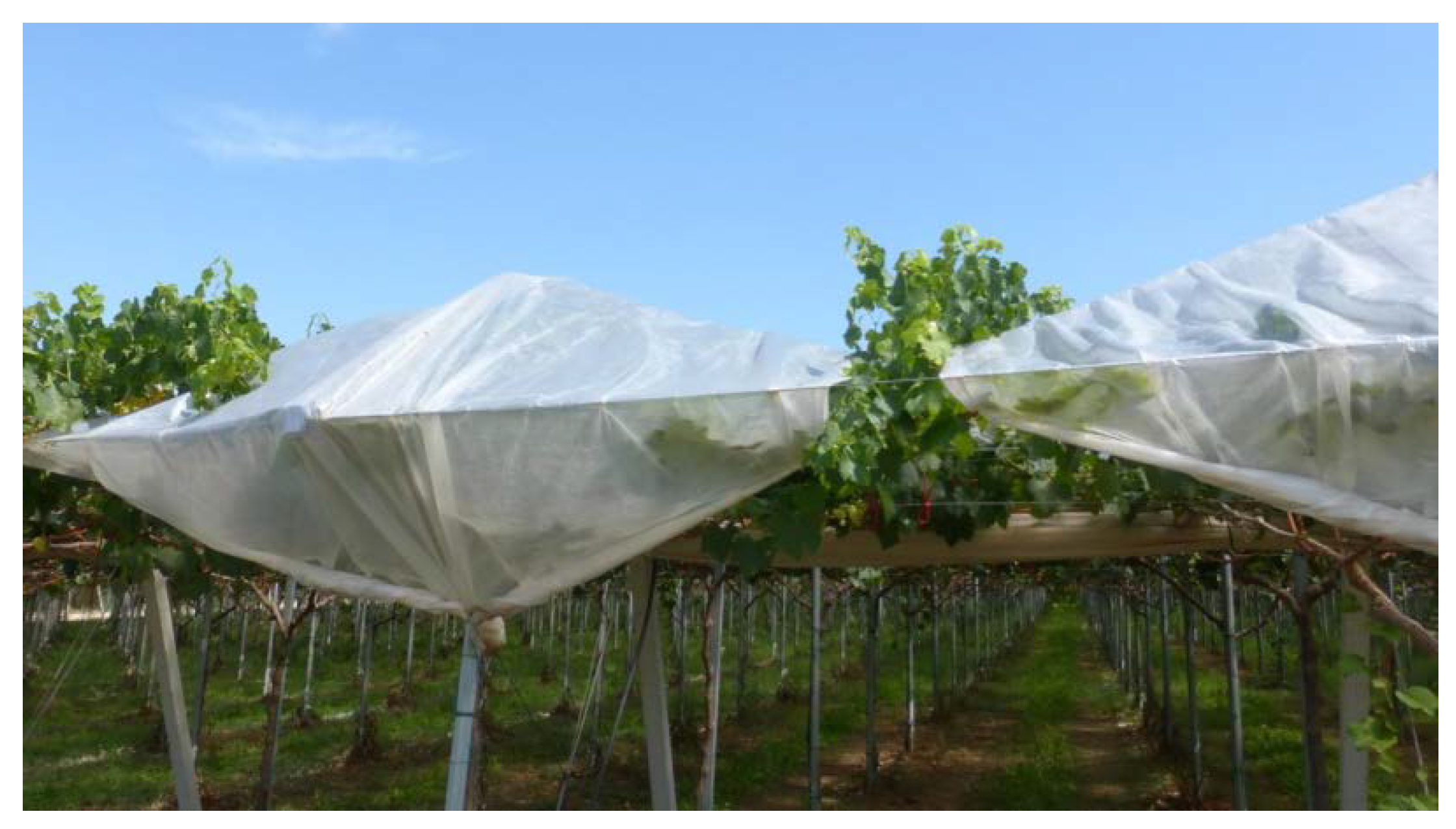
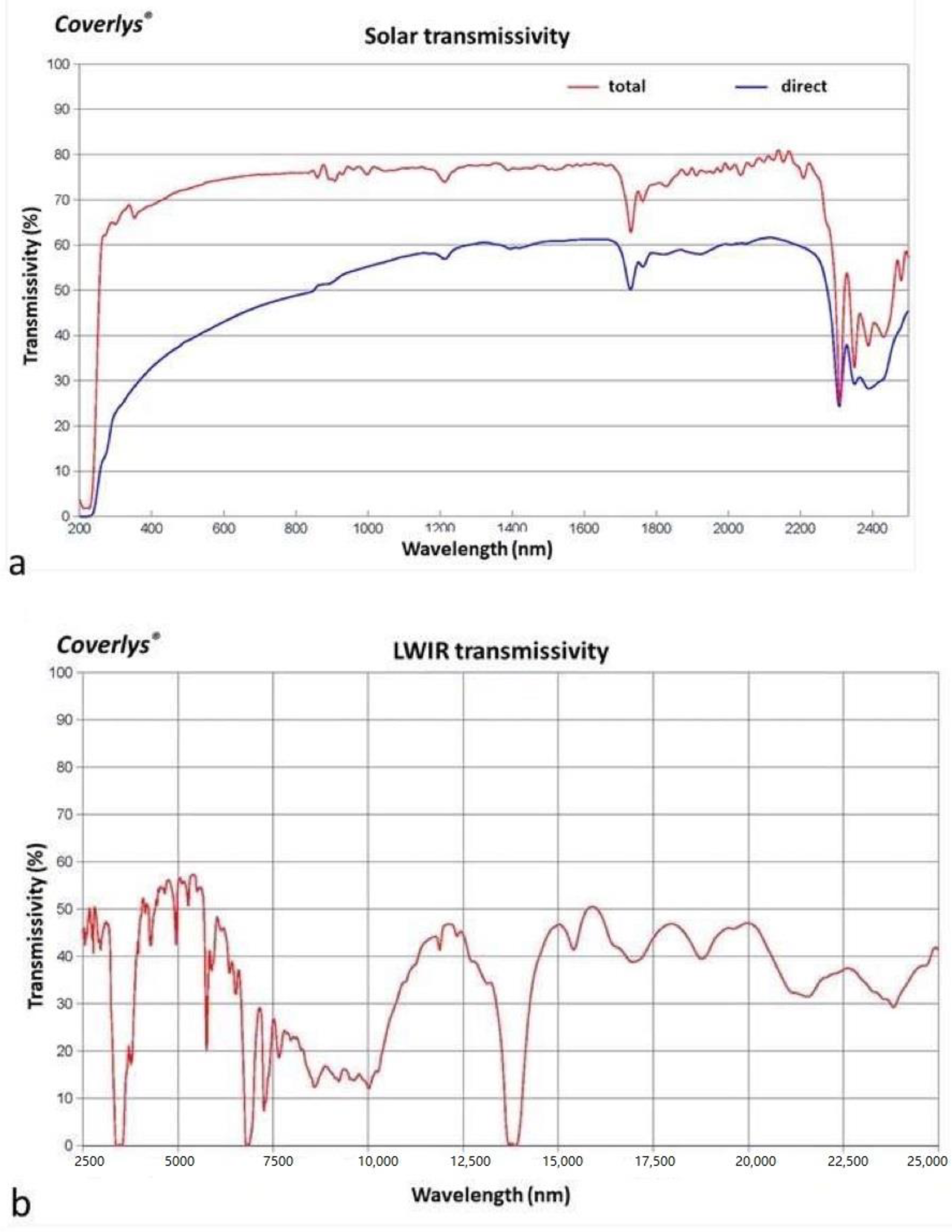
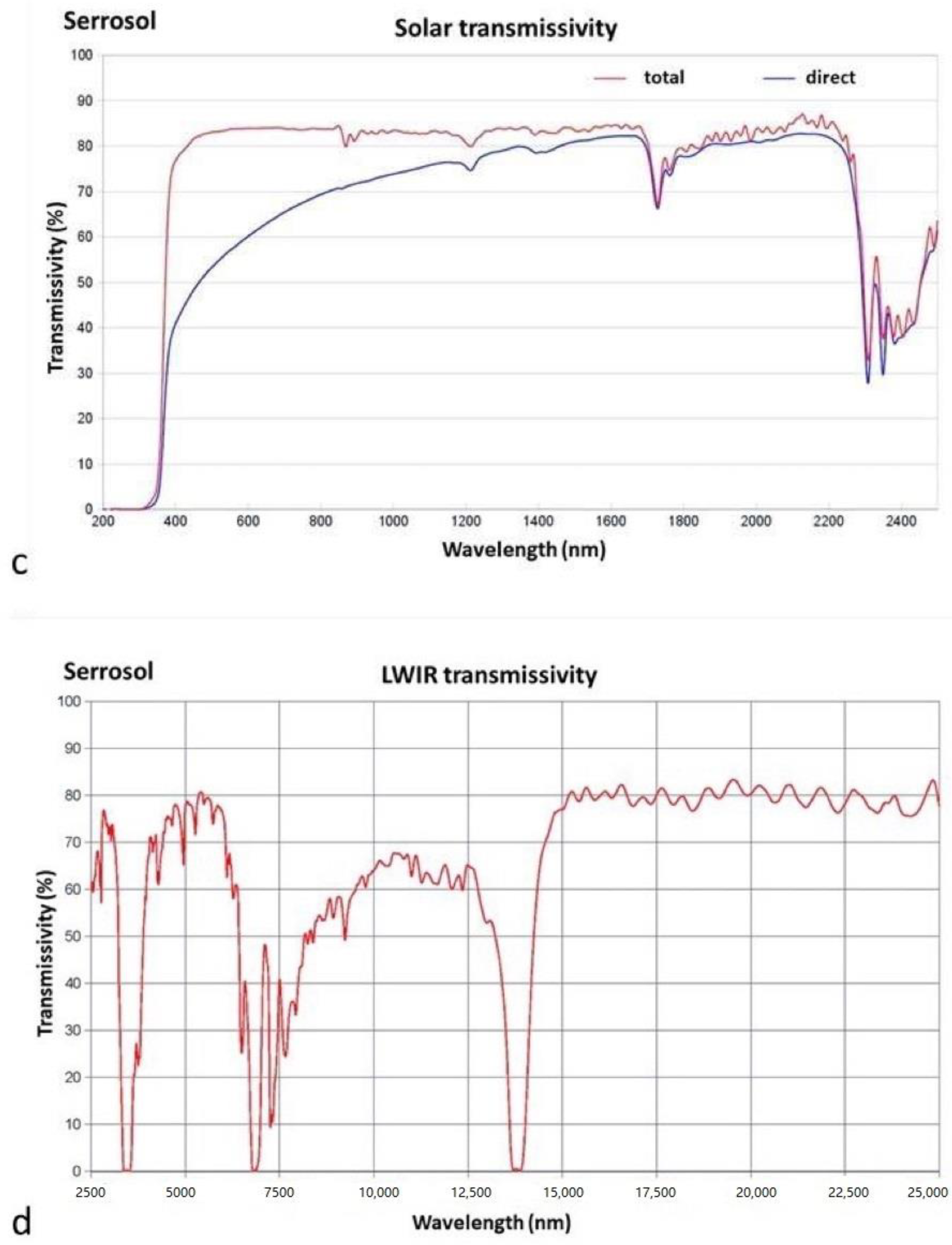

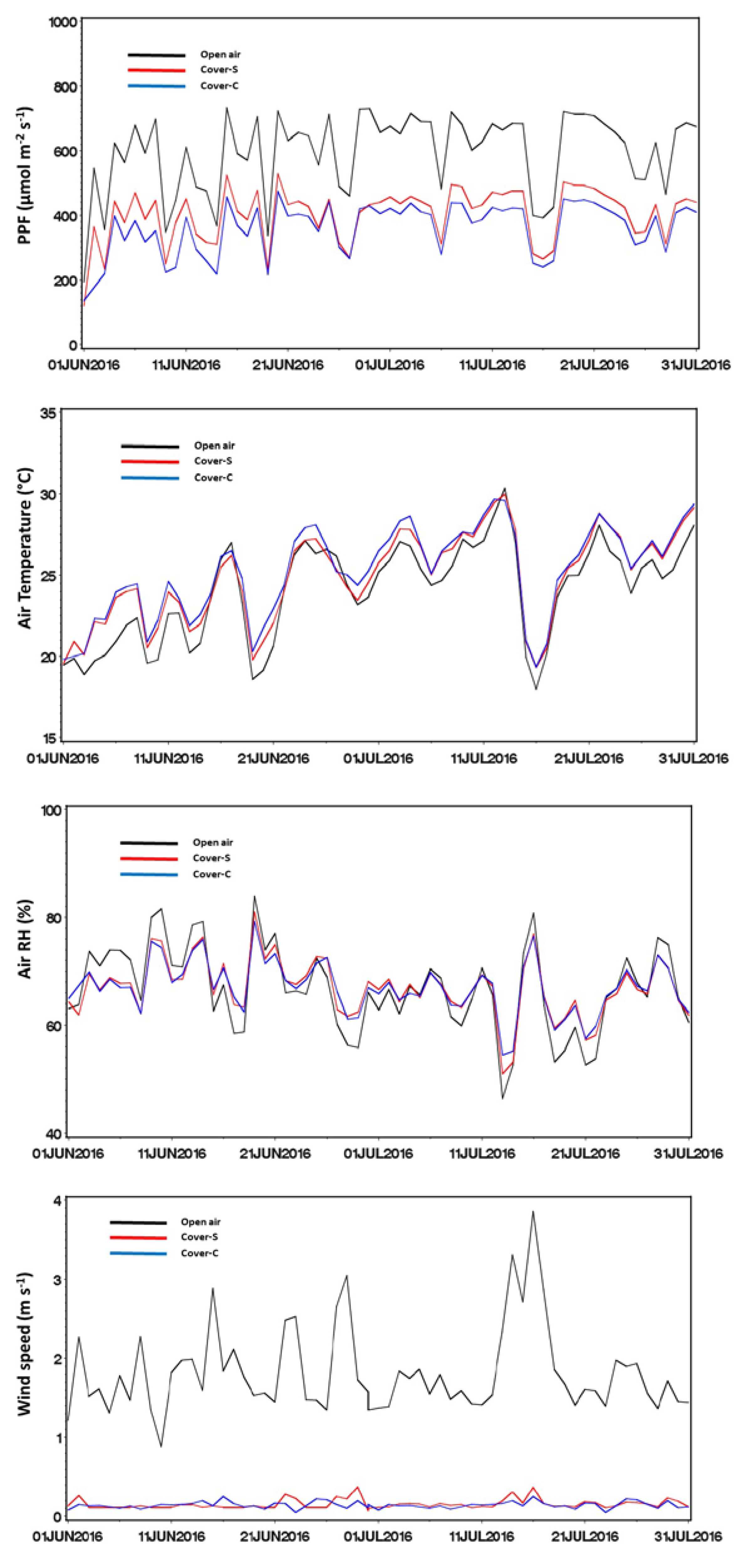

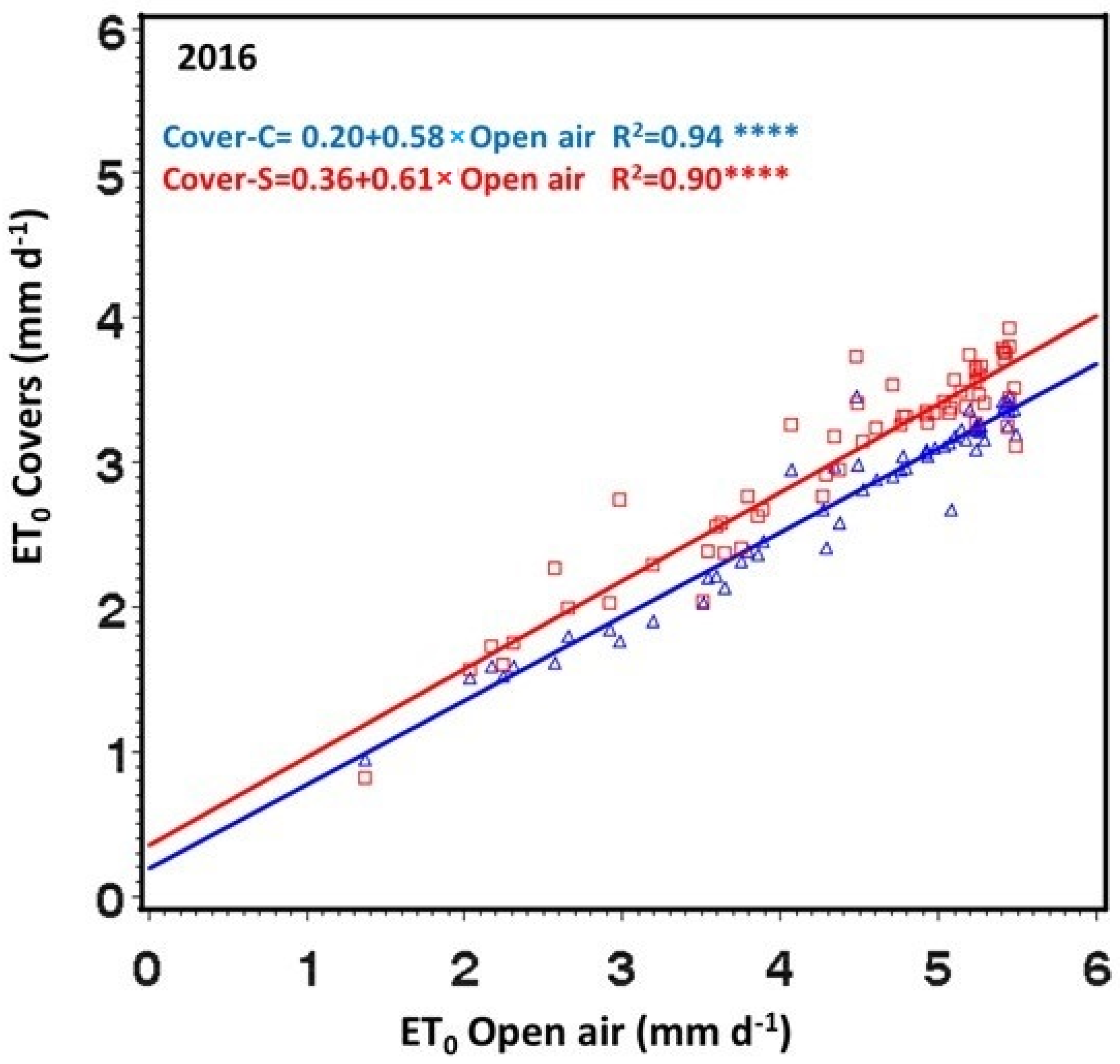
| Jan | Feb | Mar | Apr | May | Jun | Jul | Aug | Sep | Oct | Nov | Dec | |
|---|---|---|---|---|---|---|---|---|---|---|---|---|
| Mean Temp. (°C) | 8.6 | 8.9 | 11.4 | 14.5 | 18.7 | 23.2 | 25.9 | 26 | 21.9 | 17.9 | 13.8 | 9.9 |
| Avg. Min. Temp. (°C) | 5.8 | 5.8 | 7.9 | 10.6 | 14.7 | 19 | 21.6 | 21.8 | 18.4 | 14.7 | 10.9 | 7.1 |
| Avg. Max. Temp. (°C) | 11.7 | 12.2 | 15.1 | 18.3 | 22.5 | 26.9 | 29.7 | 30 | 25.4 | 21.4 | 17 | 12.8 |
| Rainfall (mm) | 58 | 53 | 56 | 52 | 36 | 29 | 22 | 20 | 52 | 60 | 64 | 64 |
| Avg. Air RH (%) | 75 | 72 | 71 | 70 | 67 | 62 | 58 | 60 | 66 | 73 | 74 | 75 |
| Rainy days (n) | 7 | 7 | 6 | 7 | 5 | 4 | 3 | 3 | 6 | 6 | 6 | 8 |
| Sunny hours (n) | 6.3 | 7.0 | 8.7 | 10.4 | 12.0 | 13.0 | 12.9 | 12.0 | 10.1 | 8.1 | 7.0 | 6.3 |
| Wavelength Range | Transmissivity (%) | |||||
|---|---|---|---|---|---|---|
| Cover C | Cover S | |||||
| Total | Direct | Diffuse | Total | Direct | Diffuse | |
| Total Solar (200–2500 nm) | 75 | 48 | 27 | 82 | 64 | 17 |
| PAR (400–700 nm) | 73 | 41 | 32 | 83 | 57 | 26 |
| NIR (700–2500 nm) | 76 | 54 | 23 | 83 | 73 | 10 |
| UV (280–380 nm) | 68 | 29 | 38 | 30 | 15 | 15 |
| LWIR (7500–12,500 nm) | 27 | 58 | ||||
| Month | Year | Cover | ET0 (mm d−1) | ET0 (mm mo−1) |
|---|---|---|---|---|
| Open air | 4.59 ± 0.13 | 137.64 | ||
| June | 1st | Cover S | 3.37 ± 0.09 | 100.96 |
| Cover C | 3.23 ± 0.09 | 97.01 | ||
| Open air | 5.07 ± 0.06 | 157.21 | ||
| July | 1st | Cover S | 3.33 ± 0.06 | 103.10 |
| Cover C | 3.29 ± 0.05 | 102.01 | ||
| Open air | 4.05 ± 0.20 | 121.56 | ||
| June | 2nd | Cover S | 2.84 ± 0.13 | 85.15 |
| Cover C | 2.55 ± 0.13 | 74.06 | ||
| Open air | 4.73 ± 0.16 | 146.79 | ||
| July | 2nd | Cover S | 3.24 ± 0.10 | 100.43 |
| Cover C | 2.95 ± 0.09 | 91.47 |
Publisher’s Note: MDPI stays neutral with regard to jurisdictional claims in published maps and institutional affiliations. |
© 2022 by the authors. Licensee MDPI, Basel, Switzerland. This article is an open access article distributed under the terms and conditions of the Creative Commons Attribution (CC BY) license (https://creativecommons.org/licenses/by/4.0/).
Share and Cite
de Palma, L.; Vox, G.; Schettini, E.; Novello, V. Reduction of Evapotranspiration in Microenvironment Conditions of Table Grape Vineyards Protected by Different Types of Plastic Covers. Agronomy 2022, 12, 600. https://doi.org/10.3390/agronomy12030600
de Palma L, Vox G, Schettini E, Novello V. Reduction of Evapotranspiration in Microenvironment Conditions of Table Grape Vineyards Protected by Different Types of Plastic Covers. Agronomy. 2022; 12(3):600. https://doi.org/10.3390/agronomy12030600
Chicago/Turabian Stylede Palma, Laura, Giuliano Vox, Evelia Schettini, and Vittorino Novello. 2022. "Reduction of Evapotranspiration in Microenvironment Conditions of Table Grape Vineyards Protected by Different Types of Plastic Covers" Agronomy 12, no. 3: 600. https://doi.org/10.3390/agronomy12030600







